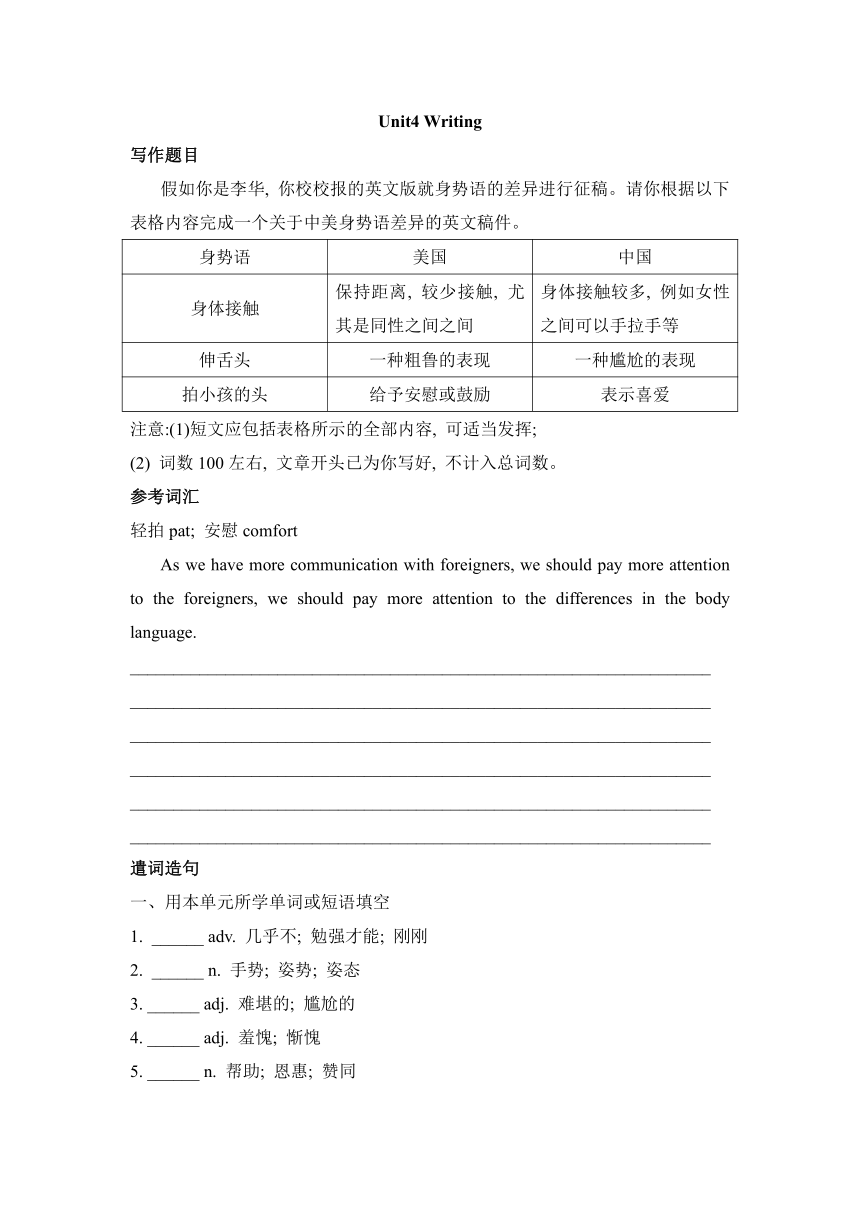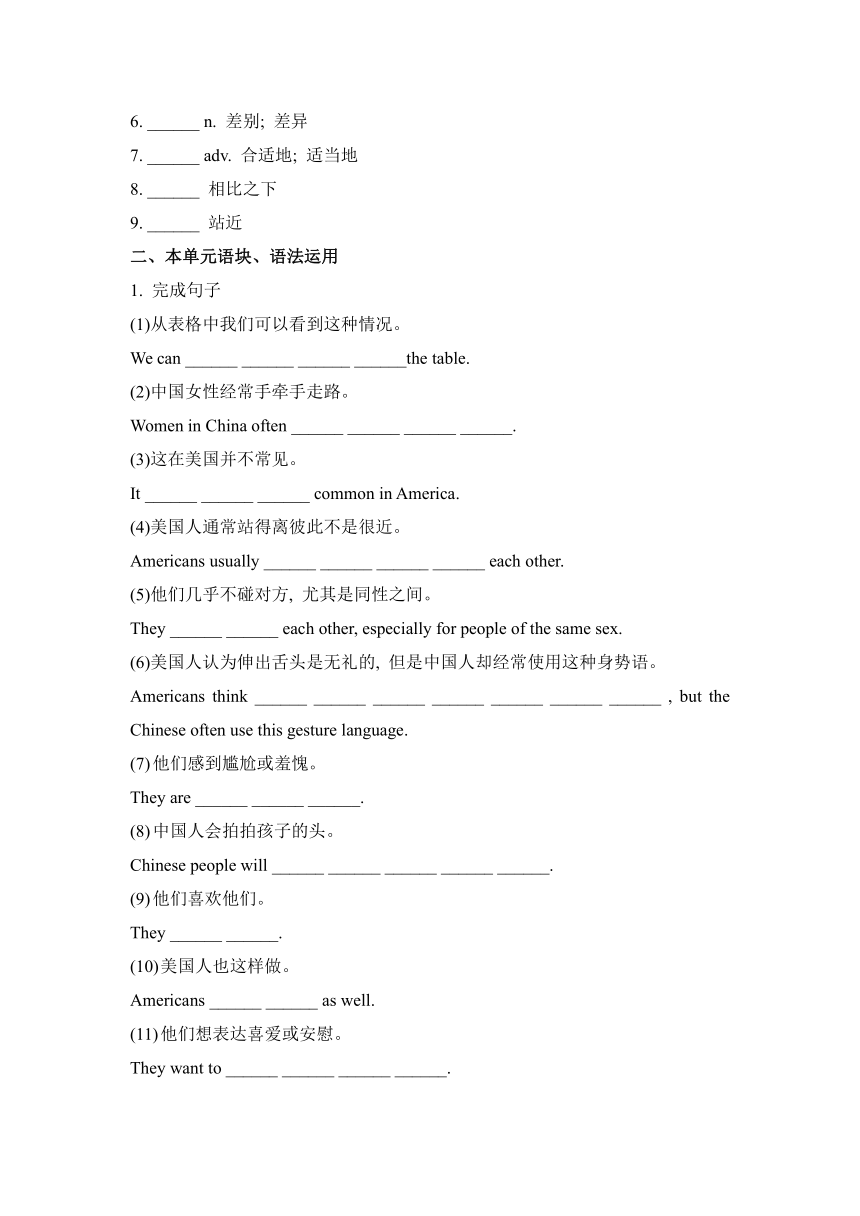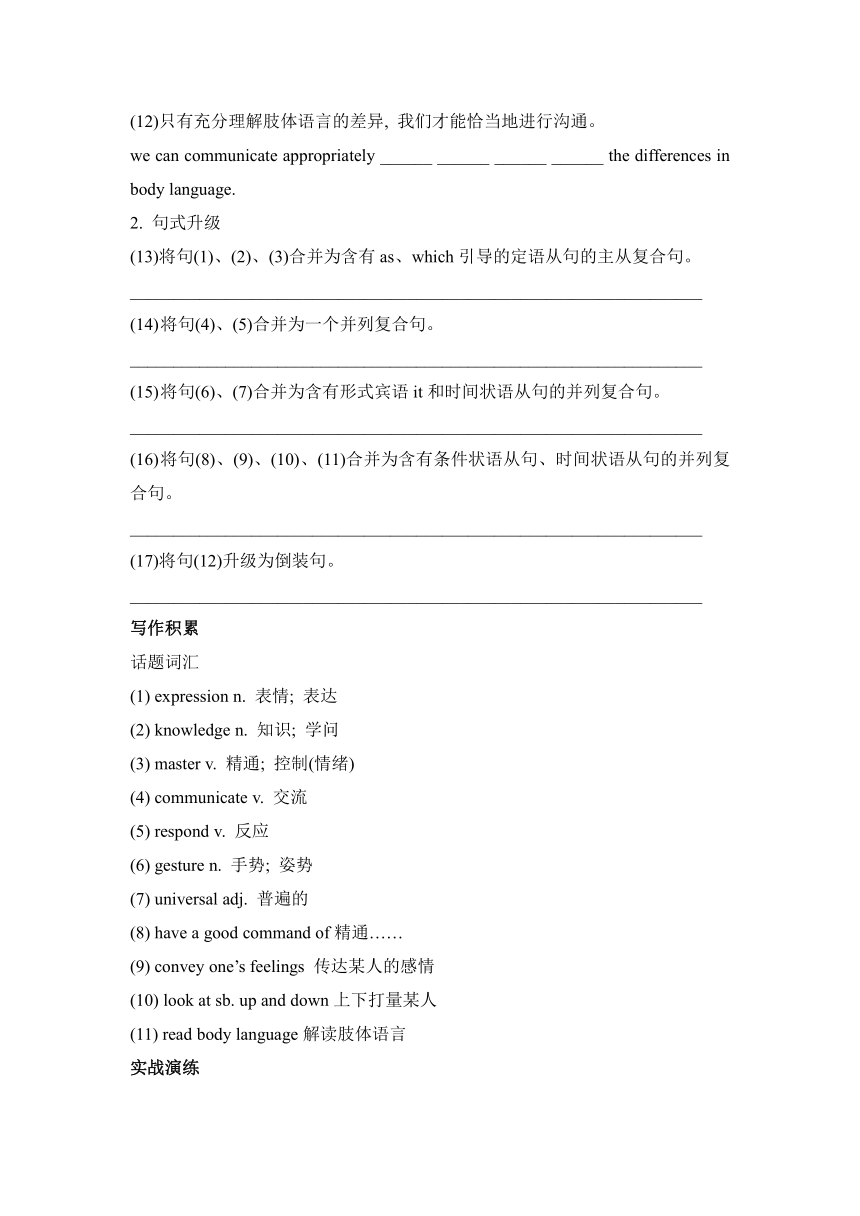人教版(2019)选择性必修 第一册Unit 4 Body Language主题写作练(含答案)
文档属性
| 名称 | 人教版(2019)选择性必修 第一册Unit 4 Body Language主题写作练(含答案) |  | |
| 格式 | docx | ||
| 文件大小 | 18.2KB | ||
| 资源类型 | 教案 | ||
| 版本资源 | 人教版(2019) | ||
| 科目 | 英语 | ||
| 更新时间 | 2023-03-11 20:29:50 | ||
图片预览



文档简介
Unit4 Writing
写作题目
假如你是李华, 你校校报的英文版就身势语的差异进行征稿。请你根据以下表格内容完成一个关于中美身势语差异的英文稿件。
身势语 美国 中国
身体接触 保持距离, 较少接触, 尤其是同性之间之间 身体接触较多, 例如女性之间可以手拉手等
伸舌头 一种粗鲁的表现 一种尴尬的表现
拍小孩的头 给予安慰或鼓励 表示喜爱
注意:(1)短文应包括表格所示的全部内容, 可适当发挥;
(2) 词数100左右, 文章开头已为你写好, 不计入总词数。
参考词汇
轻拍pat; 安慰comfort
As we have more communication with foreigners, we should pay more attention to the foreigners, we should pay more attention to the differences in the body language.
___________________________________________________________________
___________________________________________________________________
___________________________________________________________________
___________________________________________________________________
___________________________________________________________________
___________________________________________________________________
遣词造句
用本单元所学单词或短语填空
______ adv. 几乎不; 勉强才能; 刚刚
______ n. 手势; 姿势; 姿态
3. ______ adj. 难堪的; 尴尬的
4. ______ adj. 羞愧; 惭愧
5. ______ n. 帮助; 恩惠; 赞同
6. ______ n. 差别; 差异
7. ______ adv. 合适地; 适当地
8. ______ 相比之下
9. ______ 站近
二、本单元语块、语法运用
1. 完成句子
(1)从表格中我们可以看到这种情况。
We can ______ ______ ______ ______the table.
(2)中国女性经常手牵手走路。
Women in China often ______ ______ ______ ______.
(3)这在美国并不常见。
It ______ ______ ______ common in America.
(4)美国人通常站得离彼此不是很近。
Americans usually ______ ______ ______ ______ each other.
(5)他们几乎不碰对方, 尤其是同性之间。
They ______ ______ each other, especially for people of the same sex.
(6)美国人认为伸出舌头是无礼的, 但是中国人却经常使用这种身势语。
Americans think ______ ______ ______ ______ ______ ______ ______ , but the Chinese often use this gesture language.
他们感到尴尬或羞愧。
They are ______ ______ ______.
中国人会拍拍孩子的头。
Chinese people will ______ ______ ______ ______ ______.
他们喜欢他们。
They ______ ______.
美国人也这样做。
Americans ______ ______ as well.
他们想表达喜爱或安慰。
They want to ______ ______ ______ ______.
(12)只有充分理解肢体语言的差异, 我们才能恰当地进行沟通。
we can communicate appropriately ______ ______ ______ ______ the differences in body language.
2. 句式升级
(13)将句(1)、(2)、(3)合并为含有as、which引导的定语从句的主从复合句。
__________________________________________________________________
将句(4)、(5)合并为一个并列复合句。
__________________________________________________________________
将句(6)、(7)合并为含有形式宾语it和时间状语从句的并列复合句。
__________________________________________________________________
将句(8)、(9)、(10)、(11)合并为含有条件状语从句、时间状语从句的并列复合句。
__________________________________________________________________
(17)将句(12)升级为倒装句。
__________________________________________________________________
写作积累
话题词汇
(1) expression n. 表情; 表达
(2) knowledge n. 知识; 学问
(3) master v. 精通; 控制(情绪)
(4) communicate v. 交流
(5) respond v. 反应
(6) gesture n. 手势; 姿势
(7) universal adj. 普遍的
(8) have a good command of精通……
(9) convey one’s feelings 传达某人的感情
(10) look at sb. up and down上下打量某人
(11) read body language解读肢体语言
实战演练
假设你是李华, 你的英国朋友罗伯特(Robert)准备来中国学习, 因此想了解一些中国的肢体语言。请你用英语给他写封邮件, 介绍一些日常的肢体语言。
注意:(1)词数100左右;
(2)信的开头和结尾已为你写好(不计入总词数).
Dear Robert ,
_____________________________________________________________________
_____________________________________________________________________
_____________________________________________________________________
_____________________________________________________________________
_____________________________________________________________________
_____________________________________________________________________
_____________________________________________________________________
Yours,
Li Hua
答案:
思路点拨
主题 中美身势 体裁 说明文
人称 第一、三人称为主 时态 一般现在时
布局 第一段:强调身势语的重要性, 表明写作目的; 第二段:根据表格提示, 说明身体接触、伸舌头布局和拍小孩的头的中美差异; 第三段:总结差异是客观存在的, 提出彼此理解的希望。
参考范文
As we have more communication with foreigners,we should pay more attention to the differences in the body language.
As we see from the table, women in China often walk hand in hand,which is not always common in America. By comparison, Americans usually don’t stand close to each other and they barely touch each other, especially for people of the same sex. Also, Americans think it rude to put out one’s tongue, but the Chinese often use this gesture language when they are embarrassed or ashamed. Furthermore, Chinese people will pat children on the head if they like them, and Americans do so as well when they want to express favour or comfort.
In a word, differences do exist; only by fully understanding the differences in body language can we communicate appropriately.
一、1. barely 2. gesture 3. embarrassed 4. ashamed 5. favour 6. difference 7. appropriately 8. by comparison 9. stand close to
二、(1) see this situation from (2) walk hand in hand (3) is not always (4) don’t stand close to (5) barely touch (6) it’s rude to put out one’s tongue (7) embarrassed or ashamed (8) pat children on the head (9) like them (10) do so (11) express favour or comfort (12) only by fully understanding (13)As we see from the table,women in China often walk hand in hand,which is not always common in America. (14) Americans usually don’t stand close to each other and they barely touch each other ,especially for people of the same sex. (15) Americans think it rude to put out one’s tongue,but the Chinese often use this gesture language when they are embarrassed or ashamed. (16)Chinese people will pat children on the head if they like them, and Americans do so as well when they want to express favour or comfort. (17) Only by fully understanding the differences in body language can we communicate appropriately.
实战演练
One possible version:
Dear Robert,
In China, we wave our hands to say “hello” or “goodbye”. We usually greet our guests by shaking hands with them. Some people may nod and smile instead of shaking hands. When you are introduced to a Chinese group, they may greet you by clapping their hands.
Like in many countries,we nod our heads to say “yes” and shake our heads to say “no”. People will hold their thumbs up to praise a person, if he does something great. Sometimes, we bow to show great respect and thanks to others.
I hope these information will be helpful to you.
Yours,
Li Hua
写作题目
假如你是李华, 你校校报的英文版就身势语的差异进行征稿。请你根据以下表格内容完成一个关于中美身势语差异的英文稿件。
身势语 美国 中国
身体接触 保持距离, 较少接触, 尤其是同性之间之间 身体接触较多, 例如女性之间可以手拉手等
伸舌头 一种粗鲁的表现 一种尴尬的表现
拍小孩的头 给予安慰或鼓励 表示喜爱
注意:(1)短文应包括表格所示的全部内容, 可适当发挥;
(2) 词数100左右, 文章开头已为你写好, 不计入总词数。
参考词汇
轻拍pat; 安慰comfort
As we have more communication with foreigners, we should pay more attention to the foreigners, we should pay more attention to the differences in the body language.
___________________________________________________________________
___________________________________________________________________
___________________________________________________________________
___________________________________________________________________
___________________________________________________________________
___________________________________________________________________
遣词造句
用本单元所学单词或短语填空
______ adv. 几乎不; 勉强才能; 刚刚
______ n. 手势; 姿势; 姿态
3. ______ adj. 难堪的; 尴尬的
4. ______ adj. 羞愧; 惭愧
5. ______ n. 帮助; 恩惠; 赞同
6. ______ n. 差别; 差异
7. ______ adv. 合适地; 适当地
8. ______ 相比之下
9. ______ 站近
二、本单元语块、语法运用
1. 完成句子
(1)从表格中我们可以看到这种情况。
We can ______ ______ ______ ______the table.
(2)中国女性经常手牵手走路。
Women in China often ______ ______ ______ ______.
(3)这在美国并不常见。
It ______ ______ ______ common in America.
(4)美国人通常站得离彼此不是很近。
Americans usually ______ ______ ______ ______ each other.
(5)他们几乎不碰对方, 尤其是同性之间。
They ______ ______ each other, especially for people of the same sex.
(6)美国人认为伸出舌头是无礼的, 但是中国人却经常使用这种身势语。
Americans think ______ ______ ______ ______ ______ ______ ______ , but the Chinese often use this gesture language.
他们感到尴尬或羞愧。
They are ______ ______ ______.
中国人会拍拍孩子的头。
Chinese people will ______ ______ ______ ______ ______.
他们喜欢他们。
They ______ ______.
美国人也这样做。
Americans ______ ______ as well.
他们想表达喜爱或安慰。
They want to ______ ______ ______ ______.
(12)只有充分理解肢体语言的差异, 我们才能恰当地进行沟通。
we can communicate appropriately ______ ______ ______ ______ the differences in body language.
2. 句式升级
(13)将句(1)、(2)、(3)合并为含有as、which引导的定语从句的主从复合句。
__________________________________________________________________
将句(4)、(5)合并为一个并列复合句。
__________________________________________________________________
将句(6)、(7)合并为含有形式宾语it和时间状语从句的并列复合句。
__________________________________________________________________
将句(8)、(9)、(10)、(11)合并为含有条件状语从句、时间状语从句的并列复合句。
__________________________________________________________________
(17)将句(12)升级为倒装句。
__________________________________________________________________
写作积累
话题词汇
(1) expression n. 表情; 表达
(2) knowledge n. 知识; 学问
(3) master v. 精通; 控制(情绪)
(4) communicate v. 交流
(5) respond v. 反应
(6) gesture n. 手势; 姿势
(7) universal adj. 普遍的
(8) have a good command of精通……
(9) convey one’s feelings 传达某人的感情
(10) look at sb. up and down上下打量某人
(11) read body language解读肢体语言
实战演练
假设你是李华, 你的英国朋友罗伯特(Robert)准备来中国学习, 因此想了解一些中国的肢体语言。请你用英语给他写封邮件, 介绍一些日常的肢体语言。
注意:(1)词数100左右;
(2)信的开头和结尾已为你写好(不计入总词数).
Dear Robert ,
_____________________________________________________________________
_____________________________________________________________________
_____________________________________________________________________
_____________________________________________________________________
_____________________________________________________________________
_____________________________________________________________________
_____________________________________________________________________
Yours,
Li Hua
答案:
思路点拨
主题 中美身势 体裁 说明文
人称 第一、三人称为主 时态 一般现在时
布局 第一段:强调身势语的重要性, 表明写作目的; 第二段:根据表格提示, 说明身体接触、伸舌头布局和拍小孩的头的中美差异; 第三段:总结差异是客观存在的, 提出彼此理解的希望。
参考范文
As we have more communication with foreigners,we should pay more attention to the differences in the body language.
As we see from the table, women in China often walk hand in hand,which is not always common in America. By comparison, Americans usually don’t stand close to each other and they barely touch each other, especially for people of the same sex. Also, Americans think it rude to put out one’s tongue, but the Chinese often use this gesture language when they are embarrassed or ashamed. Furthermore, Chinese people will pat children on the head if they like them, and Americans do so as well when they want to express favour or comfort.
In a word, differences do exist; only by fully understanding the differences in body language can we communicate appropriately.
一、1. barely 2. gesture 3. embarrassed 4. ashamed 5. favour 6. difference 7. appropriately 8. by comparison 9. stand close to
二、(1) see this situation from (2) walk hand in hand (3) is not always (4) don’t stand close to (5) barely touch (6) it’s rude to put out one’s tongue (7) embarrassed or ashamed (8) pat children on the head (9) like them (10) do so (11) express favour or comfort (12) only by fully understanding (13)As we see from the table,women in China often walk hand in hand,which is not always common in America. (14) Americans usually don’t stand close to each other and they barely touch each other ,especially for people of the same sex. (15) Americans think it rude to put out one’s tongue,but the Chinese often use this gesture language when they are embarrassed or ashamed. (16)Chinese people will pat children on the head if they like them, and Americans do so as well when they want to express favour or comfort. (17) Only by fully understanding the differences in body language can we communicate appropriately.
实战演练
One possible version:
Dear Robert,
In China, we wave our hands to say “hello” or “goodbye”. We usually greet our guests by shaking hands with them. Some people may nod and smile instead of shaking hands. When you are introduced to a Chinese group, they may greet you by clapping their hands.
Like in many countries,we nod our heads to say “yes” and shake our heads to say “no”. People will hold their thumbs up to praise a person, if he does something great. Sometimes, we bow to show great respect and thanks to others.
I hope these information will be helpful to you.
Yours,
Li Hua
